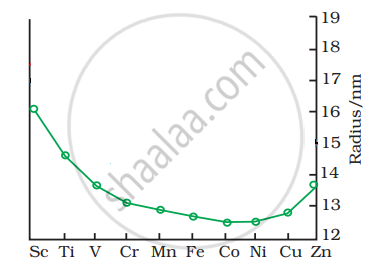Advertisements
Advertisements
प्रश्न
The trend of which property is represented by the following graph?

विकल्प
ionization enthalpy
atomic radii
enthalpy of atomization
melting point
उत्तर
Atomic radii
APPEARS IN
संबंधित प्रश्न
Which of the d-block elements may not be regarded as the transition elements?
How would you account for the following:
Cobalt (II) is stable in aqueous solutions, but in the presence of complexing reagents, it is easily oxidised.
How would you account for the following?
Transition metals and their compounds act as catalysts.
Read the passage given below and answer the following question:
The transition metals when exposed to oxygen at low and intermediate temperatures form thin, protective oxide films of up to some thousands of Angstroms in thickness. Transition metal oxides lie between the extremes of ionic and covalent binary compounds formed by elements from the left or right side of the periodic table. They range from metallic to semiconducting and deviate by both large and small degrees from stoichiometry. Since electron bonding levels are involved, the cations exist in various valence states and hence give rise to a large number of oxides. The crystal structures are often classified by considering a cubic or hexagonal close-packed lattice of one set of ions with the other set of ions filling the octahedral or tetrahedral interstices. The actual oxide structures, however, generally show departures from such regular arrays due in part to distortions caused by packing of ions of different size and to ligand field effects. These distortions depend not only on the number of d-electrons but also on the valence and the position of the transition metal in a period or group.
In the following questions, a statement of assertion followed by a statement of reason is given. Choose the correct answer out of the following choices on the basis of the above passage.
Assertion: Transition metals form protective oxide films.
Reason: Oxides of transition metals are always stoichiometric.
Which of the following will not act as oxidising agents?
(i) \[\ce{CrO3}\]
(ii) \[\ce{MoO3}\]
(iii) \[\ce{WO3}\]
(iv) \[\ce{CrO^{2-}4}\]
Why EΘ values for Mn, Ni and Zn are more negative than expected?
The halides of transition elements become more covalent with increasing oxidation state of the metal. Why?
While filling up of electrons in the atomic orbitals, the 4s orbital is filled before the 3d orbital but reverse happens during the ionisation of the atom. Explain why?
Match the properties given in Column I with the metals given in Column II.
| Column I (Property) | Column II (Metal) | |
| (i) | Element with highest second ionisation enthalpy |
(a) \[\ce{Co}\] |
| (ii) | Element with highest third ionisation enthalpy |
(b) \[\ce{Cr}\] |
| (iii) | \[\ce{M}\] in \[\ce{M(CO)6}\] is | (c) \[\ce{Cu}\] |
| (iv) | Element with highest heat of atomisation |
(d) \[\ce{Zn}\] |
| (e) \[\ce{Ni}\] |
Which one among the following metals of the 3d series has the lowest melting point?
